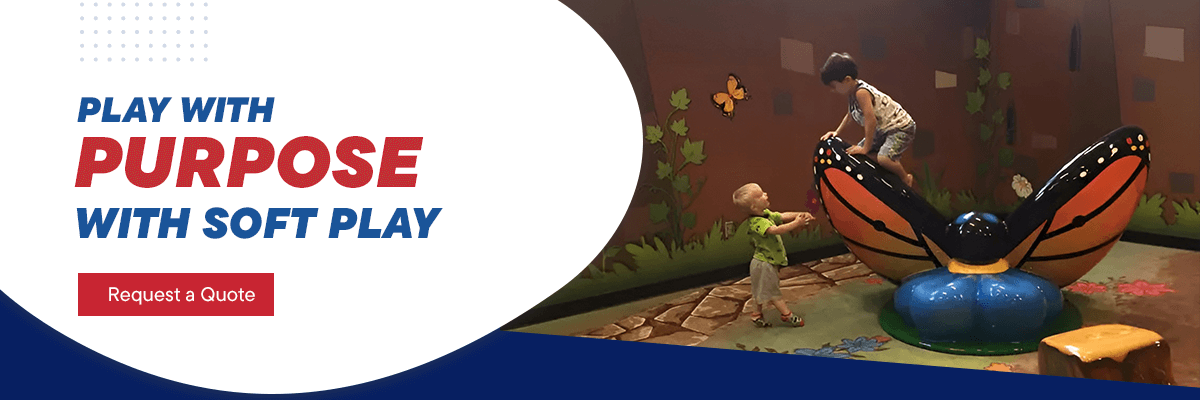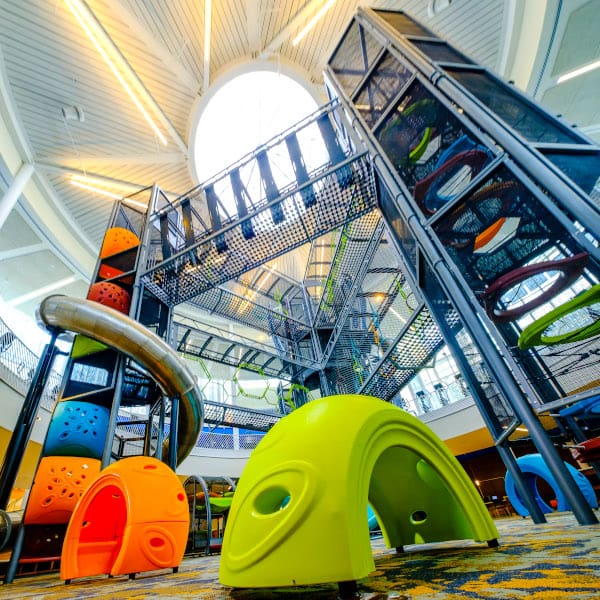How Hospitals Can Reduce Hospital Anxiety in Children
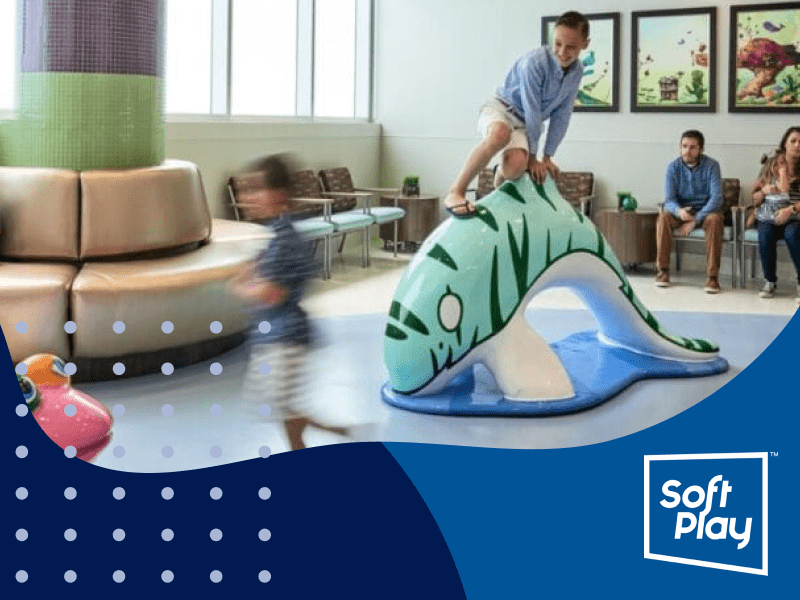
How Hospitals Can Reduce Hospital Anxiety in Children
Hospitals may not be a kid’s favorite place to visit, but their experience can be improved. As a hospital playground designer or builder, you have a unique challenge as your main customers are kids — some of which may have hospital anxiety.
You and the hospital will need to get creative to alleviate their stress and improve their and their caregivers’ hospital experience. Fortunately, a few key strategies can make all the difference in turning a hospital into a welcoming, comforting space for kids.
What Is Hospital Anxiety?
Hospital anxiety is when someone has an anxious response to hospitals, whether they’re there to undergo a medical procedure or not. They may associate hospitals with sickness, pain, uncertainty and death.
People with hospital anxiety may have other medical-related phobias, such as:
- Agliophobia: Fear of pain.
- Hemophobia: Fear of blood.
- Trypanophobia: Fear of needles.
Kids, too, can have hospital anxiety. Depending on their age, children with hospital anxiety may show their discomfort through crying, withdrawal, aggression or regression. Their responses can have different types of triggers.
Common causes of children’s hospital anxiety include:
- Unfamiliarity
- Disruption of routine
- Separation from caregivers
The Impact of Hospital Anxiety on Kids
For many kids, a hospital visit is an unfamiliar or even intimidating experience. The sterile environment, combined with new faces and strange procedures, can create a sense of fear — which can manifest emotionally, mentally and even physically.
Emotionally, anxious kids may feel overwhelmed. For them, medical settings may cause them to cry, be irritable or withdraw from the experience entirely. This stress can make it harder for them to process what’s happening.
Physically, anxiety can trigger other symptoms like stomachaches, headaches and fatigue. Their heart rate or breathing may also change as a result, which could complicate their diagnosis or treatment.
Long-term, repeated hospital anxiety may create lingering fears around medical settings. This is a real cause of concern as they may avoid future care. Additionally, this stress doesn’t just impact the kid in the moment — it can ripple out to affect parents and caregivers, who might feel helpless or struggle to comfort their kid.
Parents may try to alleviate stress through:
- Bringing comfort items from home
- Offering reassurance about their feelings
- Providing simple explanations of what’s happening
However, parents don’t have to do this alone. For instance, what happens when a kid must stay in the hospital and can’t receive reassurance from their parents? That’s where hospitals can help. Introducing interactive play and creating a kid-friendly environment can work wonders to help ease kids’ hospital anxiety.
The Power of Play in Health Care
Interactive play spaces can offer kids a fun distraction while also being a lifeline for them as they navigate the challenges of illness or medical treatment. Play areas may help in more ways than one.
Emotionally
Hospitals can feel cold and clinical, especially for kids. Playgrounds offer a joyful space where kids can reclaim a sense of normalcy. These spaces help alleviate stress in kids through play by providing an outlet for them to process their fears in a familiar and comforting environment. Playgrounds can also promote laughter, which lowers cortisol levels and, as a result, reduces stress.
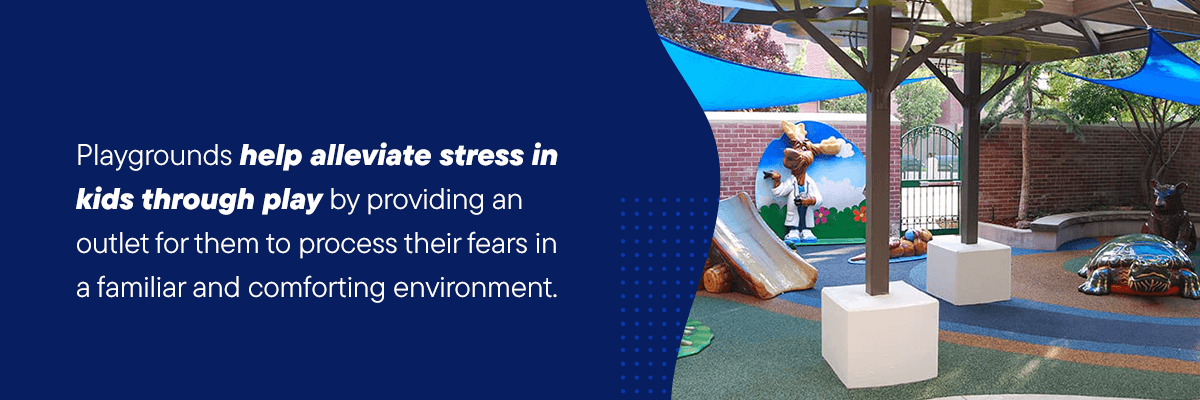
Physically
On a physical level, interactive play encourages movement, which is critical for recovery. For instance, for kids recovering from surgery or illness, play can act as a form of gentle, enjoyable physical therapy that encourages healing without feeling like “work.” Hospitals can use toys, games or other interactive activities to engage kids in physical therapy sessions.
Cognitively
Interactive elements stimulate kids’ creativity and sensory exploration. The types of interactive play options include:
-
- Visual: Bright, contrasting colors on a play area’s flooring can appeal to and engage kids.
- Tactile: Unique textures on play equipment or walls pique kids’ interest.
- Auditory: New sounds from musical features can be fun to explore.
- Vestibular: Immersive play equipment keeps kids preoccupied with practicing balance.
- Proprioceptive: Unique climbing and moving spaces allow kids to explore their personal awareness.
Encouraging kids’ cognitive development through play helps distract them during hospital visits and counteract the mental stagnation they might experience during long hospital stays.
Socially
Perhaps the most profound impact of play is its social value. Hospitals can feel isolating for young patients, but playgrounds create opportunities for connection. Kids can play with peers or their caregivers. These moments of shared play are vital for emotional health. They also help normalize the hospital experience — making it less about “being sick” and more about being a kid.
There are various advantages of play therapy for kids, and hospitals must consider it an essential part of healing. It’s a bridge between fear and comfort, isolation and connection and illness and recovery. Most importantly, thoughtfully designed play spaces can change the way kids perceive medical care.
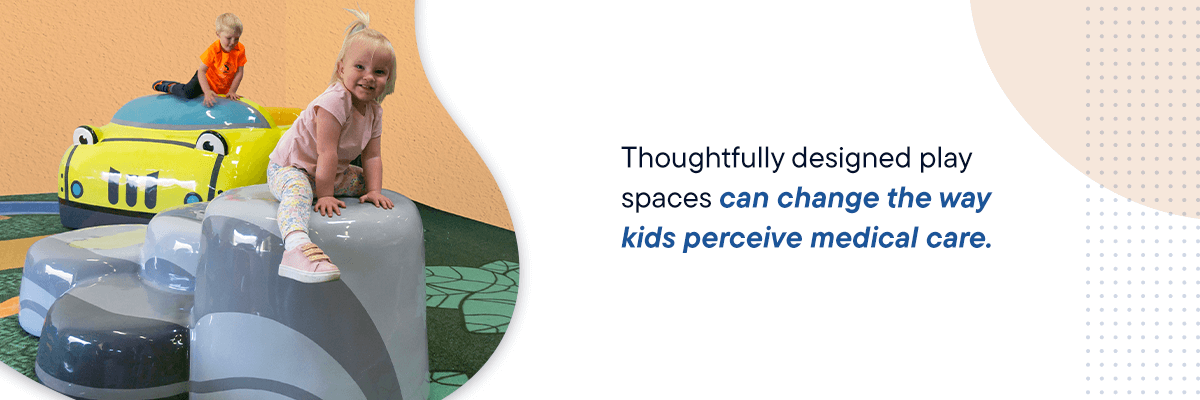
Designing Play Spaces for Hospitals
Hospital anxiety can weigh heavily on young patients, but a thoughtfully designed play space can counteract that stress.
1. Create a Sense of Comfort
Hospital environments can feel cold and clinical — and for kids, this environment may heighten their anxiety. To counteract that feeling, your playground should provide a warm, inviting atmosphere that feels worlds apart from the medical environment. Aesthetics play a role.
Use color psychology to your advantage. To contrast the clean, neutral colors of the hospital, use calming colors like blues and greens mixed with playful pops of yellow or orange to incorporate some tranquility and fun. You can even include nature-inspired themes with elements like trees, clouds or animals.
The tactile experience is equally important for creating a comfortable environment. Opt for equipment with soft edges and materials that feel gentle to the touch, such as rubberized flooring or sensory walls with different textures. Even private nooks or quiet zones give kids a retreat when feeling overwhelmed.
2. Encourage Emotional Expression
Emotions can run high in health care settings, so why not provide kids with an outlet? Research shows that kids often explore and express their emotions through play — which makes a hospital playground the perfect option to help ease kids with hospital anxiety.
A creative zone, for instance, can include design elements like art walls and chalkboards. Kids can draw, paint or write, using a therapeutic outlet for their emotions. These creative zones help kids externalize their fears and frustrations in a nonverbal way.
Imaginative play areas can also encourage emotional expression. Having a themed play area encourages imaginative play, such as storytelling and role-play and provide a form of escapism. A pirate ship or a space station can teleport kids from a hospital environment to an oceanic adventure or an intergalactic mission.
3. Design for Physical Activity and Recovery
Movement is vital for kids, especially those recovering from illness or surgery — but it can be boring. A study found that kids’ compliance with functional exercises, which are important for the healing process, was low during recovery. However, having a fun physical activity and recovery area can help combat this.
Work with the hospital’s pediatricians or other medical professionals to brainstorm physical activity exercises and activities that fit the play area’s goals, needs and design. Kids not in recovery can also benefit from a play area. Physical activity strengthens the body and releases endorphins that lift mood and reduce anxiety. Remember, your playground should offer opportunities for engaging physical activity tailored to various abilities and needs.
4. Stimulate Cognitive Growth and Curiosity
Staying in the hospital may disrupt a kid’s daily routine and limit the learning opportunities they’d otherwise be experiencing in school. Being in an unfamiliar environment with different routines can also heighten kids’ hospital anxiety. To help address these obstacles, integrate play features that spark their curiosity and cognitive engagement.
One example is to install interactive panels with puzzles, mazes or games that challenge problem-solving skills. These activities can stimulate critical thinking and keep kids mentally active. You can even include science and nature elements like butterfly gardens or water tables to further pique their curiosity.
Play areas that include virtual reality (VR) can give kids an immersive play experience that’s sure to entertain and educate. For example, VR can bring murals or sculptures to life, such as turning a painted jungle wall into an interactive learning adventure about animals and plants. Studies have even shown that VR significantly improves the hospital experience for kids with anxiety.
5. Promote Social Interactions
Playgrounds are natural gathering places. Kids can socially connect and build new friendships and confidence in the normalcy that a playground provides. One study found that a playground helped kids connect while alleviating their stress.
Take the Junior Interactive Challenge Course, for example. This course brings even younger kids together for some thrilling fun, which could even encourage teamwork. The course is a great distraction while promoting friendly age-appropriate competition.
Some kids may need a break in-between all the enjoyment. Incorporating play area furniture and seating offers a place to rest and relax — and potentially get to know other kids.
6. Make Play Inclusive
All kids should be able to enjoy your playground, regardless of their physical, sensory or developmental abilities. If you design an inclusive play area, you ensure each kid has the opportunity to experience the various benefits of having a playground in a hospital. An inclusive design may even foster empathy and understanding among their peers.
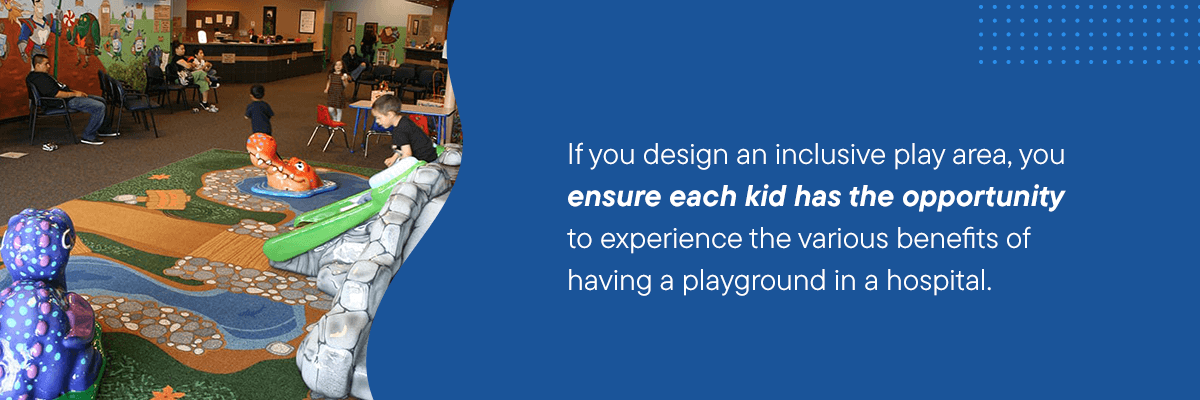
Design with universal principles in mind, making sure all equipment is accessible. Offer spaces that cater to varying sensory needs, such as high-energy zones for active play and calm sensory rooms for quiet exploration. Additionally, clear, colorful signs with symbols and braille can guide kids through the playground.
Inclusivity in design is about creating an environment where no kid feels left out and each play experience is empowering and joyful.
7. Bring the Outdoors In
If outdoor play isn’t feasible, recreate its benefits indoors. Exposure to nature, even in simulated forms, can have profound effects on stress levels, mood and well-being. So, try designing spaces that mimic the natural world.
Incorporating large windows or a skylight to bring in natural light boosts mood and happiness, potentially alleviating kids’ hospital anxiety. Add greenery, real or artificial, to mimic the outdoors and create a soothing atmosphere. Water features like small fountains or water tables provide sensory play and relaxation.
Natural elements can help kids feel more connected to the world beyond the hospital walls, reducing their feelings of confinement in an unfamiliar space.
8. Prioritize Safety and Hygiene
Hospitals require stringent safety and hygiene standards, and your playground design must reflect this. The well-being of kids depends on creating a space that’s engaging while also being meticulously safe and clean.
Always use easy-to-clean materials that are safe for kids. Opt for antimicrobial surfaces to resist germs and bacteria to keep them from spreading. Also ensure the playground remains clean by arranging a cleaning crew to regularly tend to the play area.
To further promote hygiene, include handwashing stations or sanitizer dispensers at entry and exit points.
9. Engage With Families and Caregivers
Play spaces can also provide much-needed respite for caregivers while their kids play. Design with families in mind to create a holistic space that benefits everyone.
You can achieve this by offering comfortable seating with clear sightlines so parents can supervise while resting. But who says fun is only for kids? Include interactive elements, like puzzles or games, that adults can enjoy with their kids.
10. Collaborate With Experts
Partner with health care professionals, kid psychologists and even other professional playground designers or builders to create the most impactful design. Their insights can guide you in designing features that best address kid’s needs and anxieties.
The Soft Play® Difference
When you partner with Soft Play, you’re choosing a team that understands the importance of creating more than just a playground. We design environments that are as therapeutic as they are fun. Our solutions are completely customizable — from design to installation — ensuring every space is uniquely suited to your needs.
Our philosophy’s core is inclusivity. We aim to make sure all kids, regardless of ability, can enjoy the benefits of play. With our experience in health care settings, we bring a thoughtful, balance-focused approach to play environments that support recovery while sparking joy.
Turn Vision Into Reality With Soft Play
Designing a playground for a hospital is about creating a space where kids can be kids, no matter their circumstances. You have the power to change the hospital experience of every kid who steps into your play space.
Now, imagine a play space that does more than entertain — it nurtures and inspires. With Soft Play, we’re here to turn that vision into a reality. Complete our form today, and let’s collaborate to create a space that fosters joy and engages every kid.
